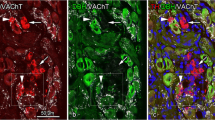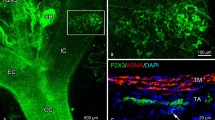Summary
The origin of nerve fibers to the superficial temporal artery of the rat was studied by retrograde tracing with the fluorescent dye True Blue (TB). Application of TB to the rat superficial temporal artery labeled perikarya in the superior cervical ganglion, the otic ganglion, the sphenopalatine ganglion, the jugular-nodose ganglionic complex, and the trigeminal ganglion. The labeled perikarya were located in ipsilateral ganglia; a few neuronal somata were, in addition, seen in contralateral ganglia. Judging from the number of labeled nerve cell bodies the majority of fibers contributing to the perivascular innervation originate from the superior cervical, sphenopalatine and trigeminal ganglia. A moderate labeling was seen in the otic ganglion, whereas only few perikarya were labeled in the jugular-nodose ganglionic complex. Furthermore, TB-labeled perikarya were examined for the presence of neuropeptides. In the superior cervical ganglion, all TB-labeled nerve cell bodies contained neuropeptide Y. In the sphenopalatine and otic ganglia, the majority of the labeled perikarya were endowed with vasoactive intestinal polypeptide. In the trigeminal ganglion, the majority of the TB-labeled nerve cell bodies displayed calcitonin gene-related peptide, while a small population of the TB-labeled neuronal elements contained, in addition, substance P. In conclusion, these findings indicate that the majority of peptide-containing nerve fibers to the superficial temporal artery originate in ipsilateral cranial ganglia; a few fibers, however, may originate in contralateral ganglia.
Similar content being viewed by others
References
Akiguchi I, Fukuyama H, Kameyama M, Koyama T, Kimura H, Maeda T (1983) Sympathetic nerve terminals in the tunica media of human superficial temporal and middle cerebral arteries: Wet histofluorescence. Stroke 14:62–66
Coons AH, Leduc EH, Connolly JM (1955) Studies on antibody production. 1. A method for the histochemical demonstration of specific antibody and its application to a study of the hyperimmune rabbit. J Exp Med 102:49–60
Drummond PD, Lance JW (1983) Extracranial vascular changes and the source of pain in migraine headache. Ann Neurol 13:32–37
Elkind AH, Friedman AP, Grossman J (1964) Cutaneous blood flow in vascular headaches of the migraine type. Neurology 14:24–30
Graham JR, Wolff HG (1938) Mechanism of migraine headache and action of ergotamine tartrate. Arch Neurol Psychiatry 39:737–763
Grunditz T, Håkanson R, Sundler F, Uddman R (1988) Neuronal pathways to the rat thyroid revealed by retrograde tracing and immunocytochemistry. Neuroscience 24:321–335
Jansen I, Uddman R, Hocherman M, Ekman R, Jensen K, Olesen J, Stiernholm P, Edvinsson L (1986) Localization and effects of neuropeptide Y, vasoactive intestinal polypeptide, substance P, and calcitonin gene-related peptide in human temporal arteries. Ann Neurol 20:496–501
Jensen K, Olesen J (1985) Temporal muscle blood flow in common migraine. Acta Neurol Scand 72:561–570
Mayberg MR, Zervas NT, Moskowitz MA (1984) Trigeminal projections to supratentorial pial and dural blood vessels in cats demonstrated by horseradish peroxidase histochemistry. J Comp Neurol 223:46–56
O'Connor TP, Kooy D van der (1986) Pattern of intracranial and extracranial projections of trigeminal ganglion cells. J Neurosci 6:2200–2207
Oka N, Akiguchi I, Matsubayashi K, Kameyama M, Maeda T, Kawamura J (1987) Density of sympathetic nerve terminals in human superficial temporal arteries: Potassium permanganate fixation and monoamine oxidase histochemistry. Stroke 18:229–233
Olesen J, Edvinsson L (1988) Basic Mechanisms of Headache. Elsevier, Amsterdam
Sawchenko PE, Swanson LW (1981) A method for tracing biochemically defined pathways in the central nervous system using combined fluorescence retrograde transport and immunohistochemical techniques. Brain Res 210:31–51
Skagerberg G, Björklund A, Lindvall O (1985) Further studies on the use of the fluorescent retrograde tracer True blue in combination with monoamine histochemistry. J Neurosci Methods 14:25–40
Uddman R, Edvinsson L, Jansen I, Stiernholm P, Jensen K, Olesen J, Sundler F (1986) Peptide-containing nerve fibres in human extracranial tissue: a morphological basis for neuropeptide involvement in extracranial pain? Pain 27:391–399
Author information
Authors and Affiliations
Rights and permissions
About this article
Cite this article
Uddman, R., Edvinsson, L. & Hara, H. Axonal tracing of autonomic nerve fibers to the superficial temporal artery in the rat. Cell Tissue Res. 256, 559–565 (1989). https://doi.org/10.1007/BF00225604
Accepted:
Issue Date:
DOI: https://doi.org/10.1007/BF00225604




